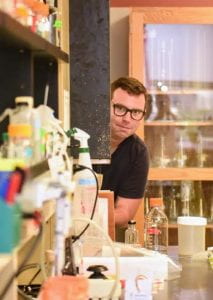About Mike:
I obtained a bachelor’s degree in Ecology & Evolutionary Biology from the University of Michigan before coming to Wayne State for my graduate studies. At Wayne State, I earned a Master of Science in Biology with a focus on neurobiology and synaptic transmission. I joined the Greenberg lab in the fall of 2017, where I serve as the manager for day-to-day operations.
In addition to my behind-the-scenes work as manager, I particularly enjoy participating in the scientific writing process in our lab. As scientists, I feel that it is of paramount importance for us to be able to clearly convey our research (and scientific principals in general) to lay audiences. This responsibility applies to everyone from undergraduates to tenured professors, and it is a skill that can always be further refined. I find the challenge of communicating science to be both fulfilling and invigorating!



When I’m not in the lab, I love to spend time outdoors, especially on the water or riding my bike. I also enjoy fishing, hiking, and primitive camping in our beautiful state.







In Fall 2020, my wonderful colleagues nominated me for a lab manager award through the company Kerafast. Upon being selected for the award, I was asked a series of “interview” questions as follows:
1.What does a typical day look like in your position?
My day-to-day work varies considerably. I could be doing anything from pricing out supplies to proofreading a manuscript to repairing broken equipment in the lab. The one thing that I can count on is that my to-do list in the morning will almost always get shaken up throughout the day as new things arise. Our lab is a dynamic place to work, so I always have to be able to adapt!
2.What area of research does your lab focus on?
In broad terms, our lab uses genetic approaches to study the role of lipids and inositol in cellular physiology. We have two main projects that are ongoing in the lab. One is focused on understanding how the mitochondrial lipid cardiolipin impacts TCA cycle function and energy metabolism. The importance of this is highlighted by a rare genetic disorder known as Barth syndrome, which is caused by a defect in cardiolipin remodeling and is characterized by severe cardiomyopathy. The second project aims to understand the mechanism of action for the bipolar disorder drugs valproate and lithium, which have a common effect of depleting intracellular inositol. As research models, our lab utilizes both mammalian cell culture systems and yeast genetics.
3.Why did you decide to pursue a career in research? What do you enjoy about the field?
The simple answer is that I was drawn to a career in research because I’m curious and like to learn new things. The scientific method is one of the only tools we have that can objectively teach us about the world we live in. As humans, I think we all tend to be curious and ask questions about what we perceive. Why do moths circle endlessly around lights? Why do frogs start their lives as tadpoles? Why do people differ so much in their susceptibility to various diseases? At first, these kinds of questions may seem impossible to answer, but once you begin to learn about the creative ways in which researchers have approached questions like this, it becomes exciting to learn more and come up with your own ideas to test. One of the things I appreciate most about being a researcher is that whenever I become curious about something, I know that I am equipped to go to the literature and learn about it by personally looking at the data that has been published rather than just taking someone else’s word.
4.What are some recent trends in your field of research, and where do you see future research moving towards?
In the past, biologists have thought of lipids as nothing more than a structural component of cell membranes with very little diversity between different types. More recently, researchers have begun to recognize the many roles that lipids play in a wide array of cellular processes and how the structural diversity of these lipids impacts their function. I think the future of lipid research will continue to reveal the nuances of how lipids and lipid metabolism influence pathways that have historically only been thought of in terms of protein-protein interactions.
5.What advice do you have for young researchers looking to pursue this career?
Mentorship is so important for young researchers and finding a supportive mentor that is willing to invest in the development of their trainees is not a trivial process. While searching for a graduate school lab, it can be tempting to focus only on the research being performed. However, working under a principal investigator that doesn’t have your best interests in mind can not only deprive you of proper training, but can also damage your confidence and passion for science. Always remember that you are a valuable asset and don’t be afraid to look elsewhere if you aren’t getting the support you need.
6.What is a technology that interests you that you wish you knew more about?
I began college as an engineering student, with the goal of developing renewable energy alternatives to fossil fuels. Although my career path has changed, I am still fascinated by the various alternative energy technologies that exist and the challenge of their practical implementation into vehicles, equipment, etc. As a biologist, I am particularly intrigued by the concept of biofuels and the notion that we can get single-celled organisms like algae and yeast to do work for us.
7.What activities outside of work are you passionate about? What do you like to do in your free time?
When I’m not working, I love to spend time in the great outdoors. I especially like to go fishing and exploring in my canoe. There is something about the solitude of being alone on the water that has always appealed to me. Aside from this, I also enjoy biking, playing guitar, and just relaxing at home with my family.
8.Who is your favorite scientist, and in what ways are you inspired by them?
Dr. Robert Sapolsky has been a major influence on me. Dr. Sapolsky is a behavioral neuroendocrinologist at Stanford University and is probably best known for his many books and lectures on human behavior. One of his core messages is that we need to break the mold of thinking about biological questions only within a given discipline or “bucket”, as he often refers to it. For example, if you ask a geneticist why people have blue eyes, you’re likely to get a very different type of answer than if you ask the same question to an evolutionary biologist.
As an undergraduate, I studied ecology and evolutionary biology. However, while I was contemplating graduate school options, I began to realize that my curiosity often took me beyond the bounds of this single discipline. It was around this time that I picked up a used textbook co-authored by Dr. Sapolsky and was introduced to both the “bucketless” way of thinking and to Dr. Sapolsky’s captivating use of rhetoric to explain things. This inspired me to diversify my scientific training and ultimately led me to study neuroscience as a graduate student to help fill the gaps in my own understanding. Dr. Sapolsky’s teaching style has also influenced my approach to teaching and motivated me to seize every opportunity I get to teach others about biology, especially in informal settings.
9.How would your friends describe you?
I think most people would describe me as someone who is careful, calculated, and detail-oriented, although I would add that this is often taken to a fault! I also like to think that most people would consider me to be very approachable and open to having discussions about anything that is on their mind.
10.Lastly, what would you say is the most important part of being an effective manager?
From a practical standpoint, organization is crucial for day-to-day operations in a lab. If people can’t find the things they need, it’s a sure bet that time, effort, and money will be wasted, and frustration is bound to follow. An effective lab manager helps by serving as a central hub for maintaining organization and by taking on many of the time-consuming logistics of lab operations (e.g., scheduling equipment servicing, getting product quotes, etc.).
Taking a step back, an even more fundamental part of effectively managing a lab is to focus on fostering a comfortable, inclusive lab environment in which self-confidence and creativity can thrive. This necessarily needs to start from the top with a supportive principal investigator, and in our lab, Dr. Greenberg has always put this at the forefront of our lab culture. However principal investigators often have an almost endless list of responsibilities to split their time between, and for this reason, I think it is also important for a lab manager to be an approachable and accessible figure in the lab that people can come to with any thoughts, questions, concerns, or self-doubt that they may be experiencing.
I previously worked at the University of Michigan Museum of Natural History, where I prepared mammalian specimens for the research and display collections. Below is a video I was featured in that outlines this interesting process!


